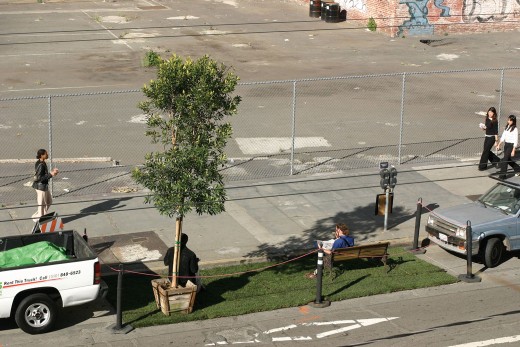Old habits die hard. However, they can be kicked to the curb if greener ones are visible, available, and within reach.
Why is it such a challenge to bring more trees and birds and parks into our urban environments when we know that most humans enjoy trees and birds and parks in their lives? Why is there so much resistance any time a major public infrastructure project is proposed that would daylight a creek, green a median, or turn a congested street into a butterfly sanctuary when nobody ever said they hated creeks, plants, and butterflies? Why are we so attached to an outdated, drab, and fossil-burning industrial-age concrete jungle when solutions are readily available to simplify, beautify, and green our existence?
The answer, you guessed it, is habit. Better the devil you know than the devil you don’t know, as the saying goes. Or, as in this case, the angel you don’t know. I’ve heard merchants fight tooth and nail for a single storefront parking spot in the face of gaining countless new customers from increased foot traffic through a proposed, canopied pedestrian boulevard. I’ve witnessed my entire city’s bicycle infrastructure plan come to a grinding halt for four years because of a single resident’s meltdown over the effect it would have on the flow of auto traffic.
Fear of change is a powerful emotion. Unfortunately, it takes only a few vocal people with strong attachments to the status quo to stonewall any kind of movement, no matter how beneficial it could be for the common good. The antidote to this fear of the unknown is to make the unknown visible, if just for brief moments and in small doses. This process is like turning on a flashlight in a cave to catch a glimpse of the beautiful paintings all around—once you’ve experienced a snippet of their beauty, you can imagine what it would be like if the whole space were illuminated. And being the social animals that we are, once we know how to shine a light on something new and inspiring, we want to share it with others.
The way to most effectively stage such a natural “interruption” of the regularly scheduled, dreary asphalt programming may vary from country to country and culture to culture. In the United States—a decidedly individualistic society with an innate distrust of government and authority—the most effective way to “change the program”, in my experience, is for individuals or a small group of creative and determined citizens to simply flick on the light switch.
For example, the wildly successful Pavement to Parks program in my adopted hometown of San Francisco did not originate in the city’s planning, public works, and transportation departments that currently jointly administer it. The seed for Pavement to Parks, which is intended to facilitate the conversion of underused spaces in the street into publicly accessible open spaces, was planted over a decade ago by urban visionaries at a small art and design studio (Rebar) who decided one day to convert a single metered parking space into a temporary public park on a plighted downtown street. Feeding the meter its maximum allowed parking time, they created a two hour green space and called it Park(ing).

The original PARK(ing) installation by Rebar. San Francisco, 2005. Photo Rebar.
As the photo of the intervention traveled across the Internet, Rebar began receiving requests to create the PARK(ing) project in other cities. However, rather than replicate the same installation, they decided to promote it as an open-source project, empowering others to create their own parks in their own cities and neighborhoods.
This turned into PARK(ing) Day, an annual global event where citizens, artists, and activists collaborate to temporarily transform metered parking spaces into temporary public places. By 2011, there were 975 parks in 162 cities in 35 countries on 6 continents. In San Francisco, there are now over 50 permanent parklets, with new proposals being filed all across the city.

Ciencia Publica, a parklet holding exhibits on the theme of sustainable water use, was co-developed by Exploratorium’s Studio for Public Spaces and community-based organizations in San Francisco’s Mission District. Photo: Sven Eberlein
So what was it that broke San Franciscans’ old habit of assuming curbsides to be reserved for cars only, leading them to accept a new and officially sanctioned reality in which these spaces could be redesigned into public parks? For one, it took a small group of creative thinkers to re-envision a public space and boldly act on it.
Secondly, a number of early adopters spread the idea, creating a necessary critical mass for accepting a new reality.
Next, the installations needed to be localized, temporary, and fluid, giving the general public just enough of a sampling to inspire them, without feeling imposing.
And finally, city agencies needed to step in at just the right time, seizing the momentum of maximum public support to enshrine the new vision into city policy and to normalize what had previously been unthinkable.
Old habits die hard. However, in urban planning, just as in our personal lives, they can be kicked to the curb if greener and healthier ones are visible, available, and within reach. Change is possible if we enact it together—creatively, and one step at a time.
This article was first published by The Nature of Cities as part of last month’s Global Roundtable on how to make urban nature and its value more visible to people. Check out the rich and diverse tapestry of reflections on the topic by over a dozen contributors from across the globe.








Good to know more about the origins of PARK(ing) Day!
I really like the story a lot. It’s so simple and raw but consequential. Sometimes you just need to see it to believe it.